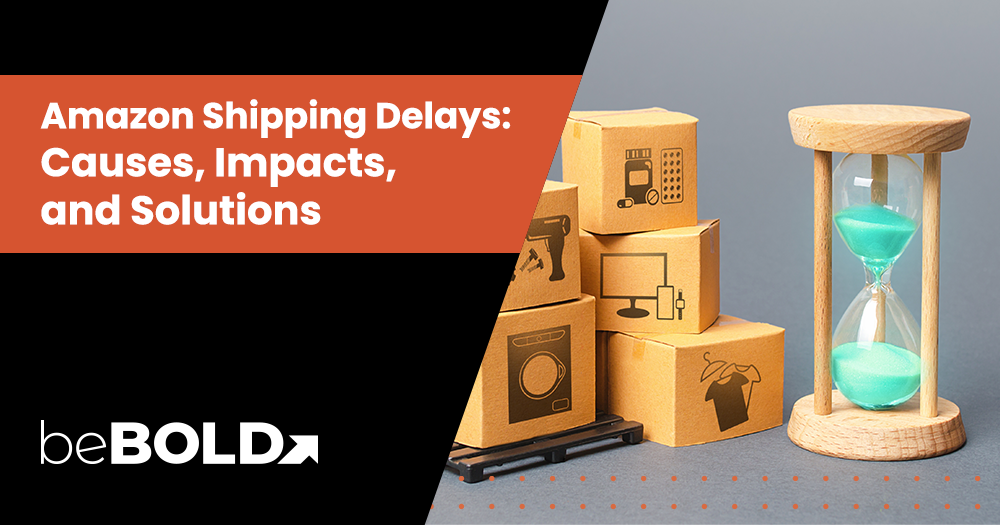Key Highlights
- Amazon shipping delays in 2025 are rising, impacting customer satisfaction, seller performance, and long-term brand trust during peak seasons like Prime Day and the holidays.
- Inventory misplacement, carrier limits, weather disruptions, labor shortages, and geopolitical issues are key reasons behind order delays affecting both FBA and third-party sellers.
- Sellers face serious consequences like lower search rankings, negative reviews, and account health risks from consistent delivery issues or stockouts.
- Proactive steps such as smarter inventory distribution, multi-channel fulfillment, and clear communication help sellers reduce delay risks and protect customer loyalty.
- Customers can minimize frustration by tracking orders, updating addresses, contacting sellers, or choosing products fulfilled directly by Amazon for faster delivery.
- beBOLD Digital helps brands build resilient fulfillment strategies, ensuring product availability, faster deliveries, and stronger performance even during high-demand periods.
Amazon shipping delays in 2025 are becoming a major threat to both customer satisfaction and seller performance. When delivery promises are broken, trust erodes fast. As stated by Shippo, 19% of consumers say they’d stop shopping with a retailer after experiencing a delivery issue, and 42% say their loyalty depends on how the issue is handled. Hence, with rising order volumes, especially during Prime Day, Black Friday, and the holiday season, you just can’t afford to overlook the cracks in the fulfillment process, as an Amazon seller. Let's discuss the causes behind these Amazon shipping delays, how they impact seller metrics and customer loyalty, and what you can do to stay ahead.
What are the Common Reasons for Delay in Amazon Packages?

Shipping delays aren’t random; they’re often the result of multiple pressure points within Amazon’s complex logistics system. To set realistic delivery expectations, sellers must understand the root causes of delays and proactively plan for disruption. Here are the most common Amazon shipping delays reasons, 2025:
1. Inventory Positioning & Fulfillment Challenges
If inventory isn't strategically placed across Amazon’s fulfillment network, orders may need to be shipped from distant locations. This increases transit time and disrupts the entire fulfillment process, especially during spikes in demand. Poor stock availability near the buyer directly impacts Amazon’s ability to meet delivery promises. In some cases, brands also overlook how carrier services, like USPS weekend deliveries, affect final-mile performance.
If you're wondering, does USPS Deliver on Saturday?, we've broken that down in detail
2. Carrier Capacity Constraints
During high-demand periods, like Prime Day, Black Friday, or the holiday season, carrier networks often reach capacity. Limited transportation resources mean delays in picking up or delivering packages, even if they're ready to ship. This bottleneck affects both standard and expedited shipping services, regardless of the delivery speed promised.
3. Weather & Natural Disasters
Severe weather events, like hurricanes, snowstorms, or floods, can shut down transportation routes and delay operations at Amazon fulfillment centers. Natural disasters impact local and regional deliveries, often without warning, making it difficult to maintain promised delivery dates or reroute Amazon shipments in time.
4. Labor Shortages & Strikes
A shortage of warehouse workers, drivers, or last-mile delivery personnel can cause processing delays across the entire supply chain. Strikes in transport or logistics sectors worsen the situation, slowing down sorting, packing, and shipping of Amazon orders, especially during high-volume periods.
5. Geopolitical Tensions & Tariffs
Trade restrictions, new tariffs, or customs complications due to geopolitical issues can delay cross-border shipments. Sellers relying on international suppliers often face longer wait times, increased shipping costs, and unpredictability in delivery windows, directly affecting the availability and timely delivery of their products.
Learn how Amazon tariff prices are disrupting product costs across industries.
6. Delay in Logistics
Operational errors such as misrouted packages, scanning failures, or bottlenecks in Amazon’s logistics infrastructure can delay even in-stock items. These internal glitches, especially during peak times, create a ripple effect that delays multiple orders and affects customer satisfaction across the platform. That's why delivery drivers start using a route planner to plan and optimize their delivery journey during peak times.
7. Issues with Supplier Causing Delays
When suppliers fail to deliver stock on time, due to raw material shortages, production delays, or their own logistical issues, it stalls the entire fulfillment process. Products arrive late at Amazon fulfillment centers, resulting in backorders, delayed listings, and missed delivery windows for customers.
Want to avoid these delays impacting your Amazon business? Partner with beBOLD Digital for smart inventory planning and fulfillment strategies that keep your business moving, no matter the disruption.
What Customers Can Do About Delays

Instead of simply wondering is Amazon experiencing shipping delays? or asking why is Amazon having shipping delays? It’s important to know how you, as a customer, can take proactive steps. Whether you’re a Prime member or not, understanding how to respond can help set realistic delivery expectations and minimize frustration. Here are a few simple things you can do:
1. Track Your Orders

Use Amazon’s "Track Package" feature to stay updated on the status of your delivery. It gives real-time insights into your package’s location, estimated arrival, and any interruptions caused by seasonal trends or disruptions in the shipping network.
Keeping an eye here can help you plan accordingly.
2. Check your Address
One of the most common causes of delay in Amazon shipping is an incorrect or outdated delivery address.
Always double-check your saved addresses before placing an order, especially if you’ve moved recently or are sending a gift. A small typo can lead to delays in Amazon shipping or failed deliveries entirely.
3. Contact Customer Service
If your order is significantly delayed past the promised delivery date, don’t hesitate to reach out to Amazon’s customer service representatives. They can help identify the cause of the delay, offer updates, and in many cases, provide compensation like refunds or credits. Reaching out promptly can help preserve a positive reputation for your Amazon shopping experience.
4. Contact the Seller

If the item was sold by a third-party Amazon seller, delays may be related to their inventory, shipping process, or supply chain issues. Use the “Contact Seller” option in your order details to inquire about the cause of the delay, ask for updated shipping timelines, or request a resolution. Most sellers are responsive, especially if it helps them avoid negative feedback and maintain their seller metrics.
5. Consider Alternative Sellers
When delays stem from a third-party seller’s fulfillment challenges, it may be worth checking if the same product is available from another seller or fulfilled by Amazon. Products shipped through Amazon Prime or directly from an Amazon fulfillment center typically benefit from faster, more reliable delivery.
Switching to an alternative seller can help you avoid future delays and maintain your sales momentum, especially during time-sensitive periods like holidays or Prime Day.
How Shipping Delays Impact Sellers?

For Amazon sellers, shipping delays don’t just mean late packages; they signal deeper problems that can erode trust, reduce visibility, and damage long-term growth. Here's how these disruptions can hurt your business performance across multiple levels:
- Sales Velocity and Stockouts: Shipping delays can lead to stockouts, causing a drop in sales velocity. Amazon's algorithm may lower organic search rankings for affected products, making it harder to recover lost momentum. Each day without inventory means missed opportunities that compound over time.
- Customer Reviews and Feedback: Late deliveries often result in negative reviews, which can harm a seller's reputation. Customers may leave one-star reviews citing "late delivery" or "shipping problems," affecting conversion rates and overall seller ratings.
- Account Health Metrics: Persistent shipping issues can damage key performance metrics like Late Shipment Rate (LSR), Order Defect Rate (ODR), and Inventory Performance Index (IPI). Poor
- Amazon seller metrics can lead to penalties, reduced storage limits, and even account suspension.
Don’t let shipping delays derail your Amazon success. beBOLD Digital helps sellers protect rankings, avoid stockouts, and maintain customer trust with smarter fulfillment strategies. Book a call today.
Proactive Measures for Sellers to Reduce the Risk of Shipping Delays
Instead of reacting to problems after they occur, successful Amazon sellers take proactive steps to reduce the risk of shipping delays and protect their performance metrics. Here's what you can do:
1. Strategic Inventory Management
Preventing delays starts with keeping the right products in the right places at the right time. Here’s how to improve your inventory management strategy:
- Use historical sales data and forecasting tools to predict demand spikes during peak times.
- Set automated restock alerts so you're notified before inventory levels drop too low.
- Distribute inventory across multiple Amazon fulfillment centers to reduce shipping time and improve coverage across regions.
Well-positioned inventory helps ensure you meet promised delivery dates and maintain sales momentum.
2. Diversify Fulfillment Channels
Relying solely on FBA can be risky when Amazon’s fulfillment centers face delays. A more flexible setup can safeguard your business:
- Split your inventory between FBA and third-party logistics (3PL) providers to maintain backup stock during disruptions.
- Consider the Merchant Fulfilled Network (MFN) as a contingency plan to ensure continued sales and order fulfillment.
- Use regional 3PLs to speed up local delivery and reduce dependency on Amazon’s shipping network.
Diversifying fulfillment reduces bottlenecks and helps ensure a smoother customer experience.
Curious how the fulfillment options differ from each other? Check out our in-depth breakdown of Amazon FBA vs FBM to see which model best suits your business.
3. Communicate with Customers
Even with strong planning, some delays are inevitable. But how you communicate makes all the difference:
- Send proactive updates about potential delays, especially during peak seasons, natural disasters, or unexpected global events.
- Be transparent about shipping timelines to set realistic delivery expectations.
- Use branded messaging or follow-up emails to show customers you’re taking ownership of the situation.
Clear, honest communication helps preserve trust and prevents negative feedback from delayed deliveries.
Want to strengthen buyer relationships and reduce negative feedback from delays? Explore our Amazon customer engagement tips to improve communication and build lasting customer trust.
Tired of Shipping Delays? Let beBOLD Digital Help You Stay Ahead
Amazon shipping delays in 2025 are driven by a complex mix of fulfillment challenges, capacity bottlenecks, and global disruptions. But as a seller, you don’t have to navigate these obstacles alone. At beBOLD Digital, we help brands stay ahead by optimizing inventory, streamlining logistics, and creating smart contingency plans that protect your sales and reputation, even during peak seasons. From identifying root causes to strengthening your fulfillment strategy, we bring clarity and control to your Amazon operations.
Ready to future-proof your brand against shipping delays? Let’s talk. Schedule your strategy call with beBOLD Digital today.
Frequently Asked Questions
Why is my Amazon package delayed?
Delays can result from various factors, including inventory positioning issues, carrier capacity constraints, weather disruptions, labor shortages, and geopolitical tensions.
What should I do if my package is delayed?
Contact Amazon's customer service for assistance. They can provide updates or offer compensation, such as refunds or credits, in some cases.
How can sellers prevent shipping delays?
Sellers can maintain optimal inventory levels, diversify fulfillment channels, and communicate proactively with customers to minimize the impact of shipping delays.
Facing shipping delays or fulfillment challenges on Amazon? Contact beBOLD Digital today to build a smarter, more resilient strategy that keeps your products moving and your customers satisfied, no matter the season.











Comments